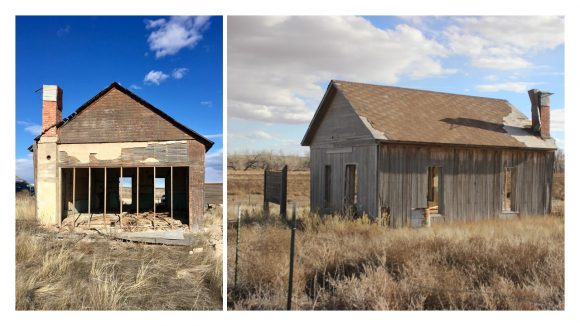Year Listed: 2018
County: Pueblo County
Construction Date: 1859
Threat When Listed: Demolition by Neglect; Vandalism
Status: IN PROGRESS
Video courtesy of CBS4
“This listing is a great way to bring many organizations together to work on the restoration/preservation of an early Colorado school and cemetery ~ Tamara Estes
The Doyle Settlement was established by Joseph Bainbridge Lafayette Doyle in 1859 when he purchased 1200 acres of land along two miles of the Huerfano River from the Vigil and St. Vrain Land Grant. Doyle was born in 1817 in Virginia (later West Virginia) and traveled to the West and Southwest as a young man. He was one of the builders of Fort Pueblo in 1842, and worked as a trapper and trader before becoming a pioneer agriculturalist, businessman, and territorial lawmaker. He married Maria De La Cruz “Cruzita” Suaso in 1844 in New Mexico. After he passed away suddenly in 1864, he left the property to his wife, whose mother, Maria Teresita Sandoval, took over management of the ranch. It remained in the family for decades, and represents Colorado’s multicultural pioneer heritage.
Joseph Doyle was elected the first county commissioner for the newly established Huerfano County and was appointed postmaster, establishing a post office at his home Casa Blanca, which no longer stands. Doyle was elected to the State Council (upper chamber of the Territorial legislature) in 1864, representing Huerfano, Pueblo, Fremont, and El Paso Counties.
Today the Doyle Settlement retains the cemetery and school building and is a beacon overlooking the Huerfano River Valley at the very southern edge of Pueblo County, about 25 miles southeast of Pueblo. The cemetery is one of the oldest burial grounds in Colorado and contains the gravestones of the Doyle family, early pioneers, and other members of the Doyle Settlement. The Doyle Settlement is recognized as a significant local historical site by people throughout southern Colorado, especially those residing in Pueblo and Huerfano Counties. It is listed on the National Register of Historic Places and owned by Pueblo County.
| “It was quite the operation he had going on around here for a number of years. He irrigated over 600 acres and also built a flour mill.” ~ Terry Hart, Pueblo County Commissioner |
A strong partnership including Pueblo County, the Territorial Daughters of Colorado-Southern Chapter, Pueblo County Historical Society, Goodnight Barn Preservation Committee, and many neighboring farmers, ranchers, and residents, including descendants of the Doyle family, is working to preserve, protect and rehabilitate the school building and cemetery site and interpret it significance to future visitors. Recent work on the site includes mothballing and the installation of protective fencing, which was done in partnership with the county during a cleanup day. The site was also nominated to the National Trust for Historic Preservation’s 11 Most Endangered Places List in 2020.






